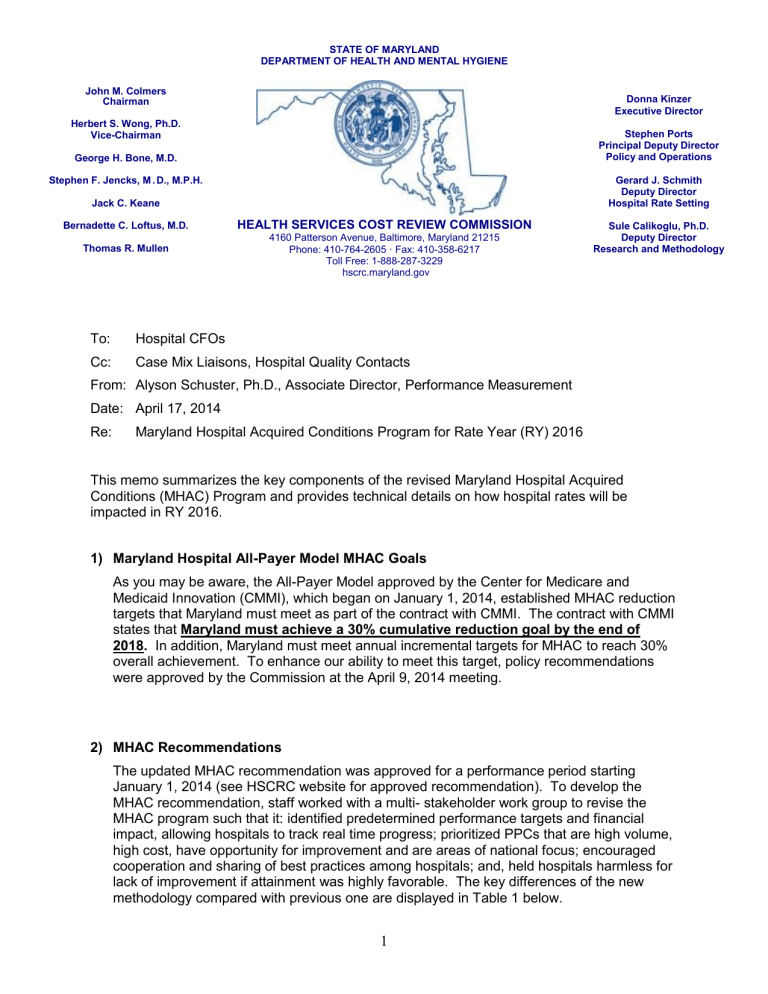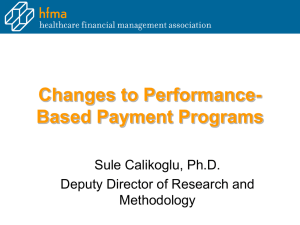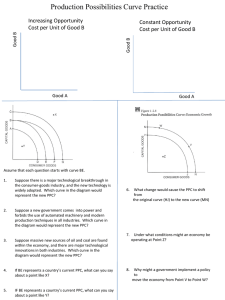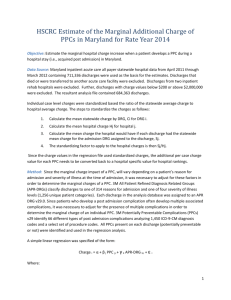MHAC FY 2016 Memo - Maryland Health Services Cost Review

STATE OF MARYLAND
DEPARTMENT OF HEALTH AND MENTAL HYGIENE
John M. Colmers
Chairman
Herbert S. Wong, Ph.D.
Vice-Chairman
George H. Bone, M.D.
Stephen F. Jencks, M . D., M.P.H.
Jack C. Keane
Bernadette C. Loftus, M.D.
Thomas R. Mullen
4160 Patterson Avenue, Baltimore, Maryland 21215
Phone: 410-7642605 · Fax: 410-358-6217
Toll Free: 1-888-287-3229 hscrc.maryland.gov
HEALTH SERVICES COST REVIEW COMMISSION
Donna Kinzer
Executive Director
Stephen Ports
Principal Deputy Director
Policy and Operations
Gerard J. Schmith
Deputy Director
Hospital Rate Setting
Sule Calikoglu, Ph.D.
Deputy Director
Research and Methodology
To: Hospital CFOs
Cc: Case Mix Liaisons, Hospital Quality Contacts
From: Alyson Schuster, Ph.D., Associate Director, Performance Measurement
Date: April 17, 2014
Re: Maryland Hospital Acquired Conditions Program for Rate Year (RY) 2016
This memo summarizes the key components of the revised Maryland Hospital Acquired
Conditions (MHAC) Program and provides technical details on how hospital rates will be impacted in RY 2016.
1) Maryland Hospital All-Payer Model MHAC Goals
As you may be aware, the All-Payer Model approved by the Center for Medicare and
Medicaid Innovation (CMMI), which began on January 1, 2014, established MHAC reduction targets that Maryland must meet as part of the contract with CMMI. The contract with CMMI states that Maryland must achieve a 30% cumulative reduction goal by the end of
2018. In addition, Maryland must meet annual incremental targets for MHAC to reach 30% overall achievement. To enhance our ability to meet this target, policy recommendations were approved by the Commission at the April 9, 2014 meeting.
2) MHAC Recommendations
The updated MHAC recommendation was approved for a performance period starting
January 1, 2014 (see HSCRC website for approved recommendation). To develop the
MHAC recommendation, staff worked with a multi- stakeholder work group to revise the
MHAC program such that it: identified predetermined performance targets and financial impact, allowing hospitals to track real time progress; prioritized PPCs that are high volume, high cost, have opportunity for improvement and are areas of national focus; encouraged cooperation and sharing of best practices among hospitals; and, held hospitals harmless for lack of improvement if attainment was highly favorable. The key differences of the new methodology compared with previous one are displayed in Table 1 below.
1
Table 1. Previous and New MHAC Methodology Comparison
Dimension Previous MHAC Program
RY 2016
New MHAC Program
RY2016
Score Calculation Excess cost of PPCs/total revenue at risk
Weights
Observed/Expected Ratio
Estimated cost of each PPC Three tiers; high cost/high prevalence
Case Mix
Adjustment
APR-DRG/ Severity of
Illness with limited case exclusions weighted more heavily (50% of total score)
Current Policy + small cell size exclusions
(at risk<10, expected <1)
Attainment/
Improvement
Performance
Standards
Separate scales for improvement and attainment
75% of state average
Better of attainment or improvement
Threshold (0 Points): State average
Benchmark (Full Points): Average of top
25% best performing hospitals
Serious Reportable Events:0
Scaling Relative ranking, revenue neutral
Point-based preset scaling, may not be revenue neutral
Statewide performance impacts the scaling results
3) New Methodology for Hospital MHAC Performance Scoring a) Performance Metric
The new methodology for the MHAC program measures hospital performance using the
Observed (O) /Expected (E) ratio for each PPC. Expected number of PPCs are calculated using the base year statewide PPC rates by APR-DRG SOI. (See Appendix A for calculations). b) Adjustments to PPC Measurement
For the CY2013 base period the following exclusions will be applied.
For each hospital, cases will be removed if:
APR-DRG SOI cell has less than 2 total cases
Palliative care cases
Cases with more than 6 PPCs
For each hospital, PPCs will be removed if:
The number of cases at-risk is less than 10
The expected number is less than 1 expected.
2
The list of PPCs excluded for each hospital is provided in the excel sheet with the monthly reports. The PPC exclusion criteria is only applied to the base period and not the performance period. This was done so that scores can be reliably calculated during the performance period prior to knowing whether the above exclusions should be applied. c) Attainment and Improvement Points
Hospital’s observed/expected ratios are compared to statewide benchmarks and thresholds and converted to points from 0-10. The points for each PPC are based on the higher of attainment points or improvement points, rounded to the nearest whole number.
Attainment points are given based on the range between the benchmark and threshold.
Hospitals whose performance year rates are equal to or above the benchmark receive
10 full attainment points and hospitals whose rates are below the threshold receive 0 attainment points. Improvement points are earned based on a scale between the hospital’s base period on a particular PPC and the benchmark, and range from 0 to 9.
See Appendix B for the formulas to calculate attainment and improvement points. d) Benchmarks and Thresholds
For each PPC a threshold and benchmark value is calculated based upon the base period data. For serious reportable events, the threshold and benchmark are 0. For all other PPCs, the threshold value is the weighted mean of all O/E ratios (O/E =1) and the benchmark is the weighted mean of the top quartile O/E ratio.
The serious reportable event PPCs for the base and performance period are the following: PPC 30, 31, 32, 45, and 46.
See Appendix C for the thresholds and benchmarks based upon CY2013 data, which will be used to assess CY2014 performance and assign improvement and attainment points. e) Calculation of Hospital Overall MHAC Score
To calculate the final score for each hospital, the final points (better of attainment or improvement) for each PPC in a tier are added up and divided by the total possible points in that tier to calculate a percent score for each tier. The PPCs are grouped in tiers so that PPCs that are high cost, high volume, have opportunity to improve, and are of national priority can be weighted more heavily (Table 2). The total possible points for each PPC is 10, and hospitals may have different total possible points depending upon which PPCs, if any, are excluded for that hospital (see exclusion criteria in section b above). A list of excluded PPCs by hospital will be provided with the monthly and quarterly PPC results.
The final score is then calculated using the following formula:
Final Score = ((Score Tier 1 * 1) / (Denominator Tier 1 * 1)) +
((Score Tier 2 * 0.6) / (Denominator Tier 2 * 0.6)) + ((Score Tier 3 * 0.4) /
(Denominator Tier 3 * 0.4))
3
Table 2. PPCs in each tier and their weight
Tier Weighting PPCs Included
1
2
3
100%
60%
40%
3,4,5,6,7,9,14,16,24,28,31,35,37,38,40,42,49,54,65,66
8,10,11,17,18,19,27,41,48
1,2,12,13,15,20,21,23,25,26,29,30,32,33,34,36,39,43,44,4
5,46,47,50,51,52,53,55,56,57,58,59,60,61,62,63,64
4) Financial Impact of MHAC Performance (Scaling) a) Preset Scaling Scores and Variation by whether state-wide target is met
Scaling will be determined based on preset values that are calculated using the base year attainment points. The percent of revenue at-risk will vary for all hospitals depending on whether the statewide MHAC minimum improvement target is met.
For CY2014 performance period, the state-wide MHAC minimum improvement target is
8% improvement. The statewide MHAC improvement rate is the percentage change in the O/E ratio in the performance year compared to the base year and calculated as follows:
{[Observed in CY2014/Expected in CY2014]/ [Observed in CY2013/Observed in
CY2013]} – 1
A report will be provided from preliminary monthly data submissions and final quarterly data calculating the state-wide improvement rate. b) Revenue At-Risk for RY2016
For RY 2016, which will be based on CY2014 performance period, the Commission voted for the following scaling parameters:
If the 8% MHAC reduction minimum target is not met, the maximum revenue at risk will be 4% of permanent inpatient revenue.
If the 8% MHAC reduction minimum target is exceeded, the maximum revenue at risk will be 1% of permanent inpatient revenue and there will be rewards to hospitals with more than 0.60 score up to 1% of permanent inpatient revenue provided sufficient funds are collected through penalties.
There is a maximum state-wide total penalty limit at 0.5% of permanent inpatient revenue.
See Appendix D for the preset percent of revenue at-risk for penalties or rewards that will be assessed based upon whether or not the statewide minimum MHAC performance target is met.
4
5) MHAC Program Reporting and Calculation Sheet
To support hospitals in monitoring their performance on the MHAC program during the
CY2014 performance period, HSCRC will provide monthly preliminary reports and quarterly final reports indicating the hospital ’s current score as of the most recent data.
Case level data will also be sent to hospitals monthly via RepliWeb. These reports will also include the state-wide improvement rate since the revenue at-risk will vary depending on whether the state-wide MHAC minimum improvement target is achieved.
In addition, HSCRC staff have developed a calculation sheet for hospitals. The calculation sheet has embedded formulas that include the PPC-specific thresholds and benchmarks so that hospitals can insert their own at-risk, observed, and expected values and obtain their scores on the measures. This can be helpful in monitoring performance or modeling different scenarios.
6) Measurement Periods for RY2016 MHAC Program
For RY2016, the base year will be CY2013 and the performance year will be CY2014.
Next year, we will resume the regular base periods where the base year will be FY2014 and measurement year will be CY2015 for RY2017.
7) Version
PPC and APR version 31 will be used for RY2016 program.
HSCRC staff appreciates the Maryland Hospital Association, hospital, payer and other stakeholder collaboration in developing and implementing this policy.
HSCRC will host a webinar on Thursday, May 1, 2014 from 2pm to 3:30pm to review the information in this memo and attachments. A registration link will be posted to the HSCRC website and emailed out shortly. If you have any questions, please feel free to send them in advance via email to Alyson Schuster at alyson.schuster@maryland.gov
or telephone at 410-
764-2673.
5
Appendix A: Expected Values
The expected value of PPCs is the number of PPCs a hospital, given its mix of patients as defined by APR
DRG category and severity of illness level, would have experienced had its rate of PPCs been identical to that experienced by a reference or normative set of hospitals.
The technique by which the expected value or expected number of PPCs is calculated is called indirect standardization. For illustrative purposes, assume that every discharge can meet the criteria for having a
PPC, a condition called being “at risk” for a PPC. All discharges will either have no PPCs or will have one and possibly more PPCs. For this exercise, therefore, each discharge either has a PPC or does not have a PPC. The PPC rate is proportion or percent of admissions which have at least one PPC.
The rates of PPCs in the normative database are calculated for each APR DRG category and its severity of illness levels by dividing the observed number of PPCs by the total number of admissions. The PPC norm for a single APR DRG severity of illness level is calculated as follows:
Let:
N = norm
P = Number of discharges with one or more PPCs
D = Number of discharges that can potentially have a PPC i = An APR DRG category and a single severity of illness level
N i
P i
D i
For this example, this number is displayed as PPCs per discharge to facilitate the calculations in the example. Most reports will display this number as a rate per one thousand.
Once a set of norms has been calculated, they can be applied to each hospital. For this example, the computation is for an individual APR DRG category and its severity of illness levels. This computation could be expanded to include multiple APR DRG categories or any other subset of data, by simply expanding the summations.
Consider the following example for an individual APR DRG category.
Table 1 Expected Value Computation Example
1
Severity of illness
Level
2
Discharges at risk for
PPCs
3
Discharges with
PPCs
4
PPCs per discharge
5
Normative
PPCs per discharge
6
Expected
# of PPCs
1
2
3
4
Total
200
150
100
50
500
10
15
10
10
45
.05
.10
.10
.20
.09
.07
.10
.15
.25
14.0
15.0
15.0
12.5
56.5
For the APR DRG category, the number of discharges with PPCs is 45, which is the sum of discharges
6
with PPCs (column 3). The overall rate of PPCs per discharge, 0.09, is calculated by dividing the total number of discharges with PPCs (sum of column 3) by the total number of discharges at risk for PPCs
(sum of column 2), i.e., 0.09 = 44/500. From the normative population, the proportion of discharges with
PPCs for each severity of illness level for that APR DRG category is displayed in column 5. The expected number of PPCs for each severity of illness level shown in column 6 is calculated by multiplying the number of discharges at risk for PPCs (column 2) by the normative PPCs per discharge rate (column 5)
The total number of PPCs expected for this APR DRG category is the expected number of PPCs for the severity of illness levels.
In this example, the expected number of PPCs for this APR DRG category is 56.5 compared to the actual number of discharges with PPCs of 45. Thus the hospital had 11.5 fewer actual discharges with PPCs than were expected for this APR DRG category. This difference can be expressed as a percentage difference as well.
APR DRG by SOI categories are excluded from the computation of the actual and expected rates when there are only zero or one at risk admission statewide for the associated APR DRG by SOI category.
7
Appendix B: MHAC SCORE Calculations a) Attainment and Improvement Points
For each hospital, PPC performance is evaluated based on the higher of “Attainment
Points” in the performance period, or “Improvement Points” based on a comparison of that hospital’s PPC performance in the performance period relative to the base period.
Attainment Points (possible points 0-10):
If the PPC ratio for the performance period is greater than the threshold, the hospital scores zero points for that PPC for attainment.
If the PPC ratio for the performance period is less than or equal to the benchmark, the hospital scores a full 10 points for that PPC for attainment.
If the PPC ratio is between the threshold and benchmark, the hospital scores partial points for attainment. The formula to calculate the Attainment points is as follows:
Attainment Points = [9 * ((Hospital’s performance period score - Attainment threshold)/ (benchmark –Attainment threshold))] + .5
Improvement Points (possible points 0-9):
If the PPC ratio for the performance period is greater than the base period, the hospital scores zero points for that PPC for improvement.
If the PPC ratio for the performance period is less than or equal the benchmark, the hospital scores 9 points for that PPC for improvement. However in this case the attainment score of 10 will be higher than the improvement score and thus the attainment score will always be used to calculate the final score.
If the PPC ratio is between the threshold and benchmark, the hospital scores partial points for improvement. The formula to calculate the Improvement points is as follows:
Improvement Points = [10 * ((Hospital performance period score -Hospital baseline period score)/(Benchmark - Hospital baseline period score))] -.5 b) Rounding
For the purposes of calculating scores, the benchmarks and O/E ratios are rounded to 4 decimal places. The attainment and improvement points are rounded to the nearest whole number. The tier percent’s and final score for each hospital is rounded to 2 decimal places.
8
Appendix C: MHAC Thresholds and Benchmarks for CY2014 Performance Year
31
32
33
34
35
36
25
26
27
28
29
30
20
21
23
24
15
16
17
18
19
11
12
13
14
PPC Number Threshold Benchmark
1 1 0.6026
2
3
1
1
0.4282
0.5781
4
5
6
7
8
9
10
1
1
1
1
1
1
1
0.5058
0.5012
0.4914
0.437
0.3243
0.6096
0.1851
1
1
1
1
1
1
1
1
1
0.5754
0.4767
0.1083
0.5604
0.0806
0.3029
0.5149
0.1649
0.3946
0
0
1
1
1
1
1
1
1
1
1
0
1
1
1
1
0.2904
0.2622
0.3138
0.6087
0.261
0
0.4199
0.1159
0.1191
0
0
0
0.3951
0.0525
0.4864
0.1914
51
52
53
54
55
47
48
49
50
60
61
62
63
56
57
58
59
64
65
66
PPC Number Threshold Benchmark
37 1 0.4509
38
39
1
1
0.3283
0.4841
40
41
42
43
44
45
46
1
1
1
1
1
0
0
0.6432
0.1827
0.4336
0
0.507
0
0
1
1
1
1
1
1
1
1
1
1
1
1
1
1
1
1
1
1
1
1
0.304
0.3942
0.3954
0.4765
0.1682
0.6059
0.2608
0.1619
0.4557
0.5059
0.4812
0.5418
0.4669
0.2779
0.4157
0.2188
0
0
0.5428
0.0762
*Serious Reportable Events are PPC 30, 31,
32, 45, and 46. These have a threshold and benchmark of 0.
9
Appendix D: Scaling for Penalties and Rewards based upon Final MHAC Scores
Performance Year CY2014 State Quality Target = 8%
Final MHAC Score
Below State
Quality Target
Exceed State
Quality Target
0.46
0.47
0.48
0.49
0.5
0.51
0.33
0.34
0.35
0.36
0.37
0.38
0.39
0.4
0.41
0.42
0.43
0.44
0.45
0.25
0.26
0.27
0.28
0.29
0.3
0.31
0.32
0.17
0.18
0.19
0.2
0.21
0.22
0.23
0.24
0.52
0.53
0.54
0.55
Scores less than or equal to -4.00%
-3.88%
-3.76%
-3.65%
-3.53%
-3.41%
-3.29%
-3.18%
-3.06%
-2.94%
-2.82%
-2.71%
-2.59%
-2.47%
-2.35%
-2.24%
-2.12%
-2.00%
-1.88%
-1.76%
-1.65%
-1.53%
-1.41%
-1.29%
-1.18%
-1.06%
-0.94%
-0.82%
-0.71%
-0.59%
-0.47%
-0.35%
-0.24%
-0.12%
0.00%
0.00%
0.00%
0.00%
0.00%
-1.00%
-0.97%
-0.93%
-0.90%
-0.86%
-0.83%
-0.79%
-0.76%
-0.72%
-0.69%
-0.66%
-0.62%
-0.59%
-0.55%
-0.52%
-0.48%
-0.45%
-0.41%
-0.38%
-0.34%
-0.31%
-0.28%
-0.24%
-0.21%
-0.17%
-0.14%
-0.10%
-0.07%
-0.03%
0.00%
0.00%
0.00%
0.00%
0.00%
0.00%
0.00%
0.00%
0.00%
0.00%
10
Final MHAC Score
Scores greater than or equal to 0.8
0.64
0.65
0.66
0.67
0.68
0.69
0.7
0.71
0.56
0.57
0.58
0.59
0.6
0.61
0.62
0.63
0.72
0.73
0.74
0.75
0.76
0.77
0.78
0.79
Below State
Quality Target
0.00%
0.00%
0.00%
0.00%
0.00%
0.00%
0.00%
0.00%
0.00%
0.00%
0.00%
0.00%
0.00%
0.00%
0.00%
0.00%
0.00%
0.00%
0.00%
0.00%
0.00%
0.00%
0.00%
0.00%
0.00% 1.00%
Penalty threshold:
Reward Threshold
0.51
No rewards
0.46
0.60
*Minimum and maximum scaling scores based on CY 2013 Final Data
Attainment Scores
Exceed State
Quality Target
0.20%
0.25%
0.30%
0.35%
0.40%
0.45%
0.50%
0.55%
0.00%
0.00%
0.00%
0.00%
0.00%
0.05%
0.10%
0.15%
0.60%
0.65%
0.70%
0.75%
0.80%
0.85%
0.90%
0.95%
11








